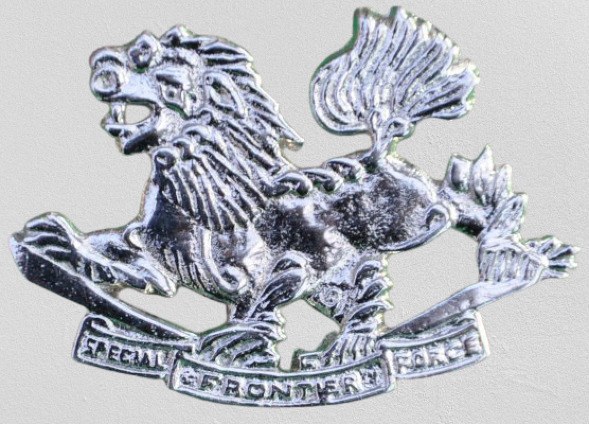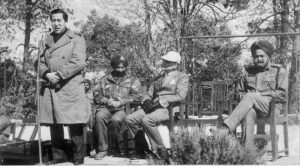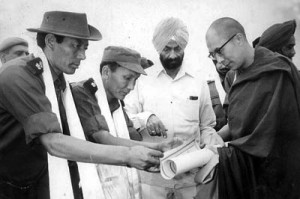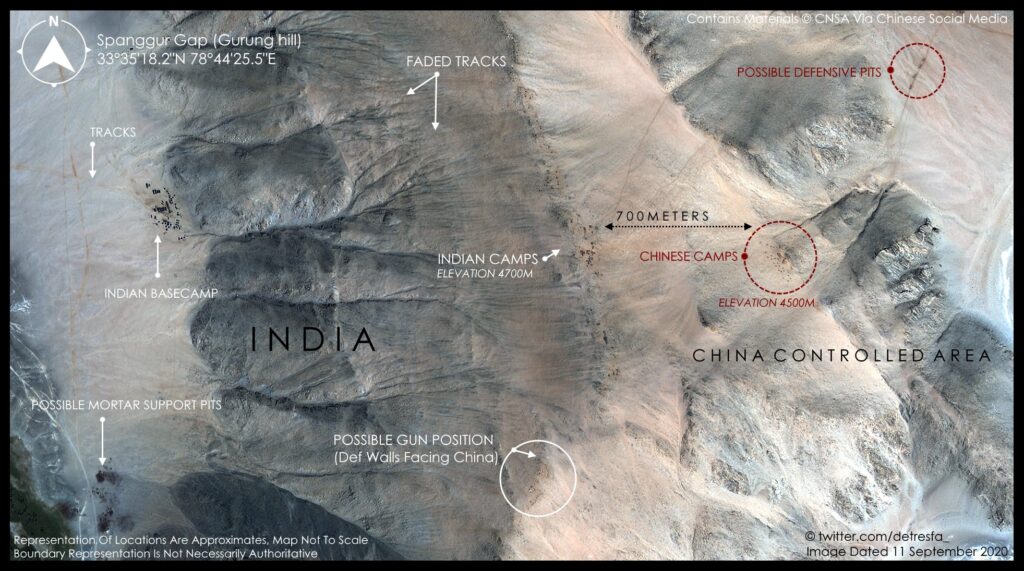
About 49 years ago, on the cold and rather scary night of November 14, 1971, in Chittagong, East Pakistan (or present-day Bangladesh), a sentry stood guarding the post of the Pakistan Special Service near his camp. At one moment, he believed he saw a “ghost” like figure lurking in the shadows. Wasting no time, the soldier open-fired at the figure. The shadowy form disappeared into the darkness of the dense forests of Chittagong Hill Tracts (CHT). The Pakistani soldier didn’t realise that the person he just shot was none other than Dhondhup Gyatotsang, one of the toughest CIA trained Tibetan guerrilla leaders serving in the Special Frontier Force (or SFF).
The SFF is one of the most secretive units operating alongside the Indian Army. Its existence is shrouded in mystery, and the missions it undertakes are virtually non-existent in the annals of Indian history. Until now, very few accounts exist about their brave adventurism in the face of adverse danger and stories of their great valour remains untold. Few have opened about the SFF and the purpose of this article is to educate the public about the existence of such an elite unit.
ORIGINS:
The Special Frontier Force (SFF) was born outborn out of a special requirement owing to the dire situation that India had found itself in the year of 1962. The period from the 1950s to 1970s has been a rather turbulent one in Tibet’s history. During this time, a lot of resistance movements came about against the incorporation into the People’s Republic of China (PRC). In 1950 the PRC had negotiated a “Seventeen Point Agreement for the Peaceful Liberation of Tibet” with the Tibetan Government in May 1951, affirming the sovereignty of China but gave the Tibet region a level of autonomy. This, however, didn’t sit well with the Tibetan people. It was and still is seen as an independent state under illegal occupation.

Tibet’s struggle for freedom in the early days was noticed by the US’s Central Intelligence Agency (CIA). While the CIA had contacts in Tibet, no such operation was undertaken. A brother of the Dalai Lama and an active politician of the Tibetan refugee community, Gyalo Thondup helped the Agency to recruit and train six such Tibetan refugees, who act as agents. Their primary goal was to assess the strength of the Tibetan refugees and in preparing for the creation of a resistance network. This convinced the Eisenhower administration at that time that the Tibetans were strong enough to sustain a campaign against the PRC. Hence the program was approved given approval by the Special Group of the United States National Security Council. The program consisted of several clandestine operations bearing the following cover names: ST CIRCUS, ST BARNUM, ST BAILEY. CIRCUS was the cover name for the training of Tibetan guerrillas on the island of Saipan and at Camp Hale in Colorado, BARNUM was the cover name for airlifting of CIA agents, military supplies, and support equipment into Tibet and BAILEY was the cover name for spreading propaganda against the Chinese. For the CIA to carry out these covert operations, they used East Pakistan (now known as Bangladesh) for geographical purposes and the proximity to Tibet. Hence these six agents were smuggled via West Bengal and into East Pakistan in February 1957 and then to Okinawa before landing in Saipan in B-17 aircrafts. Later, they would be trained in Colorado mountains owing to the similarity of the terrain topography and climate to that of Tibet. The Tibetan warriors had to be para-dropped into Tibet until India’s assistance.
By the late 1950s, the urge to have freedom from the Chinese was strong among the public and hence the rebellion started. However, to everyone’s dismay in 1959, the People’s Liberation Army took counter-offensive measures and suppressed the rebellion. The PLA ruthlessly destroyed and dispersed the guerrilla bands assisted by the CIA. More hassle was to follow post the uprising. Most of the rebels had escaped into India. A region known as Mustang in Nepal extends into Tibet and has similar Tibetan customs and hence the CIA decided to set up a base in Nepal in 1960.
Furthermore, trouble popped up when the air routes used to para-drop these trained warriors from Nepal were becoming limited. With Burma rejecting requests for flying over the Myanmar airspace and Chinese air surveillance and defence assets being moved into the Kunming province (near Myanmar), the CIA was running out of options. In late 1961, India complied with requests of such flights.
Back home in India, the situation had been troubling, to say the least. In October of 1962, the Chinese had started their attacks along the eastern and northern borders of India. The outcome of the war was disastrous for India and especially for then Prime Minister Jawaharlal Nehru. For weeks leading up to the conflict, the Chinese had tried intruding multiple times into Indian territory, and hence in response to the situation, the Prime Minister had requested for stratagems to counter the threat that loomed. While the Indian Army had submitted a viable strategy, they were outrightly rejected. Instead, a “Forward Policy” was implemented in the face of rising public criticism, with the idea of establishing several small posts facing the Chinese. The reasoning behind going with this policy against the wishes of the Army was that Nehru believed that the Chinese won’t attack. History would prove him wrong otherwise. In the month of October, the Indian Army had taken in heavy casualties in Ladakh region due to lack of preparation and military equipment.

Post this incident, the then Chief of Army Staff Lt BN Kaul and Defence Minister Krishna Menon had felt the need to raise a Tibetan force to counter the Chinese and the same was reciprocated by many in South Block in Delhi.
Hence the Special Frontier Force (SFF) was created on 14 November 1962, near the end of the Indo-China War. The Cabinet Secretariat had ordered the raising of an elite guerrilla force composed mainly of Tibetan refugees. The main goal of this task force was to conduct covert operations behind Chinese lines in the event of another Indo-China war. It was decided that Brigadier Sujan Singh Uban (later Major General) would be the first commander of this force. At that time the only other person who was in loop in raising the force was Bhola Nath Mullick, the then director of Intelligence Bureau (IB). The IB reached out to Gyalo Thondup, who was living in Calcutta at that time, and he helped in recruiting the Tibetan refugees living across various camps in India. Apart from that, assisting the IB director was former Chief Minister of Odisha Biju Patnaik. Biju Patnaik himself was an experienced aviator and ran many such clandestine air operations during the Indonesian freedom struggle from the Dutch.
After the first wave of attacks by the Chinese in October, by 19th November 1962, the Chinese forces had come close to Tezpur in the plains of Assam after facing no resistance in the Kameng sector in Arunachal Pradesh or North-East Frontier Agency (NEFA) in those times. Following the violation of the ceasefire agreement by the Chinese, both Krishna Menon and Lt Gen BN Kaul had to resign and left the office in a disgraced manner.
Meanwhile, a panic-stricken Jawaharlal Nehru wrote a letter requesting urgent military assistance from the US.
Known historian and Author Claude April revealed: “On 19 November, the day after Nehru sent two panicky letters to the U.S. President, a crucial meeting to answer Nehru was held in the White House. The then-Secretary of Defence Robert McNamara, Secretary of State Dean Rusk as well as his assistant for Far Eastern Affairs, Averell Harriman, a respected diplomat, and politician, were present. The CIA bosses were also in attendance. The declassified U.S. archives tell us: “McNamara urged that the first move be to find out what the real situation was. If we were to put our prestige and resources at risk, we must find out the score. He proposed sending a small high-level military mission immediately to Delhi, including State and Intelligence people to concert a plan of action with the Indians”.
In one of the letters, Nehru wrote: “The situation in the NEFA command has deteriorated still further. Bomdila has fallen, and the retreating forces from Sela have been trapped between Sela Ridge and Bomdila. With the advance of the Chinese in massive strength, the entire Brahmaputra Valley is seriously threatened and unless something is done immediately to stem the tide, the whole of Assam, Tripura, Manipur, and Nagaland would also pass into Chinese hands. The Chinese have amassed massive forces in the Chumbi Valley between Sikkim and Bhutan another invasion from that direction appears imminent”.
Three days later, Robert McNamara, US Secretary of Defence, the Secretary of State Dean Rusk, and Assistant for Far Eastern Affairs, Averell Harriman had arrived in India along with CIA bosses as well. After much discussion, the CIA delegation and Intelligence Bureau concluded that the Intelligence Bureau with CIA support would raise and train a 5,000 strong tactical guerrilla force and the CIA’s Far East Division would create a long-range resistance movement in Tibet and that the Tibetan warriors in Mustang in Nepal would be under CIA control.
Apart from the SFF, the Aviation Research Centre (ARC) also came into existence. It was raised on June 4, 1963, with RN Kao, founder of R&AW, spearheading the organisation. It was primarily set up for supporting the guerrilla activities of the Tibetans and operated from Charbatia in Odisha. Today the ARC flies a mix of electronic intelligence (ELINT) and signal intelligence (SIGNT) aircraft.
TRAINING AND WAR OPERATIONS:
The Special Frontier Force made Chakrata (100 km from Dehradun) in present-day Uttarakhand as their home base. There was a large population in Chakrata and was located in the foothills of the Himalayas. The Tibetan warriors started their tough training regime in rock climbing and guerrilla warfare and the training spanned for six months. Most of the weapons provided were of US origin and mainly consisted of M-1, M-2, M-3 machine guns.
In 1963, a group of CIA instructors were rotated out of the SFF home base and trained the warriors in guerrilla and irregular warfare including, para-jumping. The Special Frontier Force was renamed to “Establishment-22” or “Two-twos” owing to the fact that Major General SS Uban was a commander in the prestigious 22nd Mountain Regiment during World War II.

Since the unit was required to be parachute qualified, the Special Frontier Force moved to Agra in 1964 for para-jumping training. Agra is the home of India’s Paratrooper Training School (PTS) and houses the 50th Parachute Brigade (India). While the SFF was at Agra, a level of secrecy had to be kept from the other Army units. So, the HQ SFF had come up with a decoy name of 12 Gorkha Rifles which they would use every time they visited any establishment. In fact, they even got decoy uniforms of 12 Gorkha Rifles and always wore it. During the tenure at Agra, the SFF troops were kept apart from the rest of the quarters and others were asked not to interact with other Army officials. Ironically there have been only 11 battalions of Gorkha Rifles. Legend has it that the Tibetans excelled as parachutists.
Later, the SFF began its own airborne training program in Charbatia and then finally shifted to Sarsawa Airbase near Saharanpur, about 130 km from Chakrata.
By 1966, the strength of the unit was doubled and the Establishment was given a new name— Special Frontier Force. By the late 1960s, the SFF was divided into six battalions for better administrative purposes. Each battalion had six companies and these companies had about 123 men and was commanded by a Tibetan who attained the rank of lieutenant colonel in the Army. Even two companies comprised of Tibetan women were raised, who acted mainly as medics and communications experts.
Historically there have been very few accounts of missions undertaken by the SFF and their deployment has always remained a matter of utmost secret. Many SFF units have been deployed in many regions from Ladakh to Arunachal Pradesh along the Indo-Tibet border for gathering intelligence and monitoring the movements of the Chinese. However recent accounts prove that the SFF was used to conduct limited cross-border reconnaissance operations to place sensors on the Nanda Devi peak in 1965 in order to keep a tab on the Chinese nuclear and missile tests and this mission was a joint operation between American-Indian intelligence.

But perhaps the Special Frontier Force’s finest hour came during the 1971 India-Pakistan war and the campaign to liberate East Pakistan or Bangladesh. By October 21, 1971, the 3000 SFF commandos started moving from their base in Sarsawa and headed towards Mizoram. They had mainly four tasks at hand: 1) Destroy Mizo base, 2) Capture Chittagong, 3) capture Do Hazari and 4) block the Arkan road for the retreating Pakistani Army. This mission was led by the first Dapon, Tibetan equivalent of Brigadier, of the SFF and they were mainly equipped with US carbines and Bulgarian AK-47s. The operation was code named “Eagle”. Divided into three columns, the Tibetan warriors crossed into East Pakistan on November 10/11. They were given several missions and they completed them in no time. SFF went on to capture Chittagong and even halted Pakistan’s 97 Independent Brigade and 2 Commando Battalion in the Chittagong Hill Tracts (CHT) and stopped the retreating Pakistani forces from crossing into Burma. When the ceasefire was announced on December 17, 1971, by General A.A.K Niazi, the SFF had lost 56 men and almost 190 wounded. Since the unit was to be kept a secret, 580 troops from the SFF received cash prizes secretly. None of the members was given medals of high honour. The exploits of SFF has rightfully earned its place in Indian Military history.
With easing up of tensions and the US reaching out to China, the future of the SFF looked bleak and there were discussions were being done to ascertain the future of such a force especially after the CIA started to back out and the Nepalese government began occupying Mustang.
The answer came in 1977 when the force was tasked with counter-terrorism operations since the Tibetans aren’t directly linked with the communal politics of India. In the late ’80s and then towards the ’90s, terrorism was at an all-time high in valleys of Jammu & Kashmir. Suddenly in the newspaper, the death obituaries started appearing under the unit name of 22 Special Forces or 22 SF. The ironic part was and still is that there exists no unit in the Indian Army like 22 Special Forces. In fact, the unit was so secretive its existence was and probably still is unknown to the Army despite given the fact that the unit is staffed by Indian Army personnel. This secretive unit is known as Special Group (SG) and it is India’s primary counter-terrorism force. When the unit was formed, the Inspector General was in charge and all the Tibetans were removed and sent back to Chakrata. To keep the unit under wraps it was named 4 Vikas and it was different from other SFF units because this one is comprised of Indian soldiers and officers. For training, the Special Group was sent to Israel and worked with Israeli Special Forces. On June 6, 1984, Operation Blue Star commenced and it is believed that the Special Group was involved. The objective was to isolate Akal Takht and flush out the militants who set themselves up in the Temple. However, due to faulty intelligence, the SFF suffered heavy casualties, and eventually, tanks had to be called in to complete the operation.
Post this operation, they were sent to Jammu & Kashmir for militancy operations. Perhaps that’s where the name 22 SF was born. In the same year in 1984, the SFF units were inducted in Operation Meghdoot to seize control of Siachen Glacier. Since the SFF were acclimatised to the unforgiving terrain and excelled in mountain warfare, their involvement seemed necessary. Even today, a battalion of the SFF is stationed in the icy heights of Siachen glacier. Eventually, the SFF came to be known as “Vikas Regiment” and the battalions are known as “Vikas Battalions”. There is further evidence that the Vikas regiment was used in the 1999 Kargil War as well. However, not many details are known about their involvement and aren’t available for public scrutiny.
LINE OF ACTUAL CONTROL:
As the winter approaches, the tensions between India and China in eastern Ladakh are still running high, and end rounds of talks between both ranks at various military ranks have failed to yield results. The reason for this deadlock remains since the PLAGF (People’s Liberation Army Ground Force) refuses to move back to its positions before April 2020. The problem is graver along the northern bank of the Pangong Tso where the PLAGF has moved in and staying put at a feature called Finger 4.
In a series of pre-emptive moves, the Indian Army changed the face of the standoff and one that has not only angered the Chinese but has put them on the backfoot judging by the current scenario. On the night of August 30, the Indian Army took control of key features along a ridgeline south of Pangong Tso. The Army considers these features to be within its perception of the Line of Actual Control (LAC).

“A bold decision has been taken at Chushul at the political level. We have occupied a front along the LAC, and we surprised the Chinese. But there is heightened nationalistic fervour there too. We have to be prepared, rather than gloat,” says Lt. Gen. Rakesh Sharma, former GoC of the Leh-based 14 Corps.
But in the midst of all this operation, a casualty had been reported. Nyima Tenzing, 51, belonging to the famed 7 Vikas Battalion was killed in a landmine blast while another soldier was seriously injured. A few days later, Tenzing would receive full military honours as his last rites were being performed. However, as tragic as the death of the Non-Commissioned Officer (NCO), the fact that he belongs to one of the seven Vikas Regiment or SFF highlights the important fact that for the first time in many years India has deployed the secretive unit against the Chinese. Due to extreme geopolitical situations, the Indian government has never acknowledged the existence of the SFF.

In 1975, the SFF was prohibited from being deployed within 10km of the Indo-Chinese border after several instances where SFF commandos had conducted unauthorized cross-border operations. The standoff may be the first time that the SFF is being used against its intended target, i.e. the Chinese. While a lot can’t be commented about how the situation will pan out and when this standoff will end, the existence of the Vikas unit is an open secret. These unsung warriors have remained resilient and haven’t shown weariness about fighting other people’s war. They have stood and fought for India despite the fact that they get low pay, no reliable pension, and other benefits. Perhaps after all this is over the least India can do is grant them equal status and recognition like the other military units.
And as this article ends, somewhere in the icy heights of Eastern Ladakh, a brave Tibetan warrior stands facing his enemy and dreaming of a free Tibet.
Written by Vaibhav Aatreya for MTTN
Edited by Vaishnavi Karkare for MTTN
Featured Image: Internet
Image Sources: Indian Express, Claude Arpi Blogsite, Google Images, Bharat Rakshak, Twitter, Tibetan Journal
Leave a Reply
You must be logged in to post a comment.